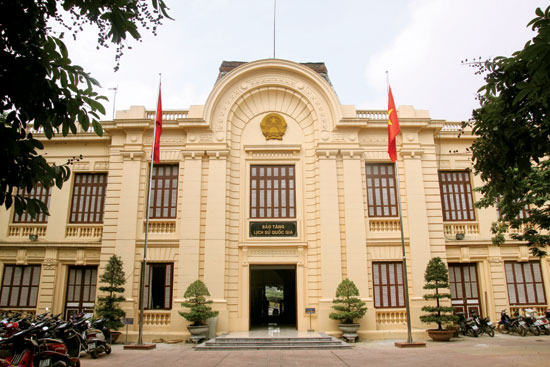(No.4, Vol.6,June-July 2016 Vietnam Heritage Magazine)
Vietnam National Museum of History
1 Trang Tien St, Hanoi / 216 Tran Quang Khai St, Hanoi
Tel: (04) 3824-1384 – Website: www.baotanglichsu.vn
8 a.m. to noon and 1.30 p.m. to 5 p.m. every day
except Monday of the first week of each month.
Currently, the Vietnam National Museum of History is hosting the special exhibition of ‘Royal treasures – Gold books of Nguyen Dynasty (1802 – 1945)’ at its main centre at 1 Trang Tien St, Hoan Kiem Dist., Hanoi until August, 2016.

The Vietnam National Museum of History was established by merging the Vietnam Museum of History and the Vietnam
Museum of Revolution under Decision No. 1674/Q?-TTg, signed by the Prime Minister on Sep. 26, 2011.
The Vietnam Museum of History was one of the earliest established, based on what was then the Louis Finot Museum of the École Française d’Extrême-Orient, built in 1929 and opened in 1932. The building was designed as a work of art, a special architectural edifice which
harmoniously combined Oriental and Occidental styles and elements of expression. In 1958, the Vietnamese government officially took over this cultural treasure, adding content and transforming it from a
museum of Eastern culture into the Vietnam Museum of History. On Sep. 3, 1958, the Museum was opened to receive visitors.
The Vietnam Museum of Revolution was based in the building of the Indo-China Chamber of Commerce, built by the French in 1917. In 1954, after the North of Vietnam was liberated, the government under Chairman Ho Chi Minh decided to start collecting content on the
history of Vietnam since the mid- 19th century to showcase in this
building as the Vietnam Museum of Revolution. The Museum was opened Jan. 6, 1959. These were the top and very first Museums of the Democratic Republic of Vietnam.
The Vietnam National Museum of History inherited all the assets and over half a century of expertise and success of the Vietnam Museum of History and the Vietnam Museum of Revolution. The two museums have done a great job of content collection and classification, museum management, staff development and building relations with other
museums, both domestic and international. The vast volume of assets that the Museum now possesses includes over 200 thousand
documents, pictures and artefacts reflecting the flow of national history from stone age to modern times, among which there are many national treasures and many of the rarest, most valuable antique collections as compared to similar
museums in the country and the region.


As head of the system of museums of
Vietnam, and as the one attracting the highest
number of foreign visitors, our Museum has
adjusted and reoriented its operations, and adapted itself to the ever-changing requirements of society. We have achieved some initial remarkable success in content delivery by modern mediums, such as auto guiding in Vietnamese and English, or through our website, which is available in Vietnamese, English and French and is accessed over seven
million times a year. Tens of thousands of pupils attend our ‘I love History’ and ‘History in artefacts’ Clubs every year. We organized major expeditions and archaeological excavations, special
exhibitions in the country and abroad, conducted research,
compilation and publication of materials, took part in domestic and international conferences, maintained and restored artefacts. We chaired some major projects such as ‘Content Building and Showcasing at Vietnam National Museum of History.’ We sent our staff to training courses both in the country and abroad. The
indoor and outdoor displays are constantly updated with new
content and improved with advanced technology and modern
exhibition styles in order to create the best possible effect and satisfy higher and higher requirements of the public.
Significantly, the Vietnam National Museum of History is one of the few national museums of Vietnam that has achieved
resounding success in its exhibitions abroad, promoting the
country and the people of Vietnam through national heritage, helping the international community have better, more complete understanding of the history and culture of Vietnam.
The Vietnam National Museum of History is a member of the International Council of Museums (ICOM) and a founding
member of Asian National Museum Association (ANMA). We have mutually beneficial bilateral and multilateral collaborative relations in the areas of archaeology, exhibition, maintenance and restoration, research, training, publishing and conferencing with many museums and research institutions of China, South Korea, Japan, Laos, The Philippines, France, Belgium, The Netherlands, UK, US, Russia and Australia.

